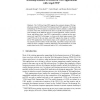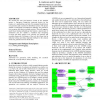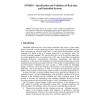UML
2004
Springer
14 years 4 months ago
2004
Springer
This paper discusses a model-based design flow for requirements in distributed embedded software development. Such requirements are specified using a language similar to Linear T...
UML
2004
Springer
14 years 4 months ago
2004
Springer
Abstract. The CASE tool ArgoUWE supports the systematic design of Web applications using the UML-based Web Engineering (UWE) approach. The design methodology of UWE is based on a m...
UML
2004
Springer
14 years 4 months ago
2004
Springer
UML
2004
Springer
14 years 4 months ago
2004
Springer
Abstract. We are developing a methodology of Test-Driven Development of Models (TDDM) based on an experimental UML2.0 modeling tool SMART. Our experience shows that TDDM is quite u...
UML
2004
Springer
14 years 4 months ago
2004
Springer
We describe the tools and interfaces created by the AGEDIS project, a European Commission sponsored project for the creation of a methodology and tools for automated model driven ...
UML
2004
Springer
14 years 4 months ago
2004
Springer
: This paper presents an overview on the workshop on Specification and Validation of Real-time and embedded Systems that has taken place for the second time in association with the...
UML
2004
Springer
14 years 4 months ago
2004
Springer
Addressing non-orthogonal software concerns that arisefrom requirements can significantly contribute to the complexity of developing large systems. Difficulties arise from the need...
UML
2004
Springer
14 years 4 months ago
2004
Springer
Use Cases have achieved wide use as a specification tool for observable behavior of systems. However, there is still much controversy, inconsistent use, and free-flowing interpreta...
UML
2004
Springer
14 years 4 months ago
2004
Springer
Precise modeling is essential to the success of the OMG’s Model Driven Architecture initiative. At the modeling level (M1) OCL allows for the precision needed to write executable...
UML
2004
Springer
14 years 4 months ago
2004
Springer
The Object Constraint Language (OCL) plays an important role in the elaboration of precise UML models. Although OCL was designed to be both formal and simple, UML/OCL models may be...



